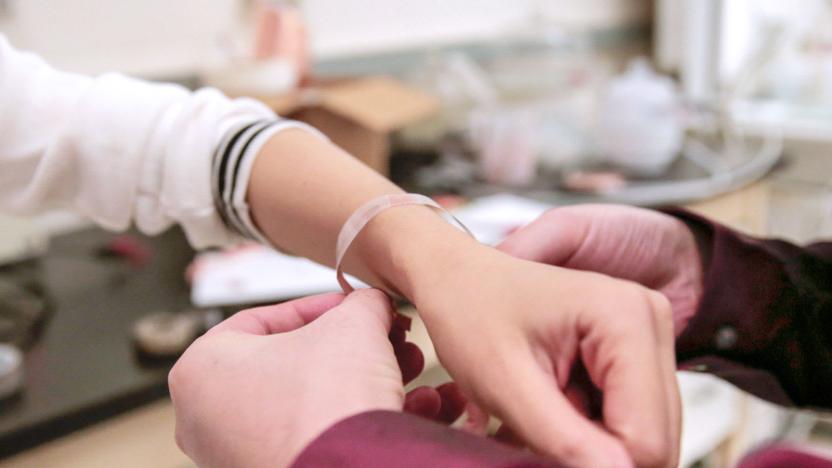nanogenerator
Latest

Self-powered electric bandages could speed up healing
Scientists have known for a long time that electricity can speed up healing for skin wounds, but the necessary power has usually tied patients to electrotherapy machines. In the future, though, it might not be much more complicated than treating a wound the old-fashioned way. Researchers in the US and China recently developed self-powered electric bandages that promise to be as easy to wear as ordinary dressings. The dressings include tiny electrodes powered by nanogenerators wrapped around your torso. All you have to do is breathe -- the movement of your ribcage activates the nanogenerators, sending low-intensity pulses to the wound area.

Indian researchers recycle fish scales into energy nanogenerator
Indians consume a lot of fish: Data from 2014 estimated that each urban citizen consumed an average of 2.8 kg per year, or about 3.7 million kg for the whole country. That leaves a lot of leftover bones, scales and tails. As they reported this week in Applied Physics Letters, a team of researchers at Jadavpur University looked for ways to re-use this "biowaste" and pioneered a method to generate electricity from it.

NASA makes longer, straighter piezoelectric nanowires in microgravity, no flat iron needed
Piezoelectric nanowires are the stuff that make power-generating pants a possibility, and that prodigious potential has drawn the attention of NASA. You see, self-powered spacesuits are awfully attractive to our nation's space agency, and a few of its finest student researchers have discovered that the current-creating strands of zinc oxide can be made longer and straighter -- and therefore more powerful -- when freed from gravity's unrelenting pull. That means nanowires grown in microgravity could lead to higher capacity batteries and the aforementioned juice-generating interstellar garb. Of course, there's no such end-products yet, but let's see if NASA can do what others have not: give pants-power to the people.

Nanogenerators produce electricity by squeezing your fingers together, while you dance
It's been a while since we last heard about nanogenerators -- you know, those insanely tiny fibers that could potentially be woven into your hoodie to juice up your smartphone. Dr. Zhong Lin Wang of the Georgia Institute of Technology has reported that he and his team of Einsteins constructed nanogenerators with enough energy to potentially power LCDs, LEDs and laser diodes by moving your various limbs. These micro-powerhouses -- strands of piezoelectric zinc oxide, 1 / 500 the width of a single hair strand -- can generate electrical charges when flexed or strained. Wang and his team of researchers shoved a collection of their nanogenerators into a chip 1 / 4 the size of a stamp, stacked five of them on top of one another and can pinch the stack between their fingers to generate the output of two standard AA batteries -- around 3 volts. Although it's not much, we're super excited at this point in development -- imagine how convenient to charge your phone in your pocket sans the bulky battery add-ons. And that's only one application of this technology. Yea, we know.

Cal researchers create 'energy-scavenging nanofibers,' look to energize your next A&F sweater
We've seen the magic of piezoelectrics before, but if a team of Cal Bears can really deliver, their spin on things will actually make a difference in the retail realm. Engineers at the University of California, Berkeley have concocted so-called "energy-scavenging nanofibers," which could one day be "woven into clothing and textiles" in order to convert into electricity the energy created through mechanical stress, stretches and twists. If everything works out, these movement-lovin' clothes could theoretically power your phone and / or PMP as you walk, and for those concerned with cost, we're told that the organic polyvinylidene fluoride materials use to make the nanofibers are easy and cheap to manufacture. Too bad there's no direct confirmation that PVDFs are machine washable, but hey, that's why you've got the local dry cleaners on speed dial.

Jacketed hamsters demonstrate movement-powered nanogenerators
Imagine this -- one day, with enough steroids, your pet hamster actually could power your home by just running on its wheel. Georgia Tech researchers have discovered ways to "convert even irregular biomechanical energy into electricity," and it's demonstrating the finding by showing off jacket-wearing rodents that are game to run. According to the institution's Zhong Lin Wang, the minuscule nanogenerators "can convert any mechanical disturbance into electrical energy," which theoretically means that power can be driven by simple, irregular mechanical motion such as the vibration of vocal cords, flapping of a flag or the tapping of fingers. As with most of these university discoveries, there's no telling how soon this stuff will be pushed out to the commercial realm, but at least they've found something to keep the rats busy during the off hours. [Via news:lite, thanks Charles]

Nanogenerator powers-up inside your veins
Scientists at the Georgia Institute of Technology are in the process of developing a nanogenerator, a tiny device which produces energy from flowing blood, constricting blood vessels, or beating hearts. Researchers say that the devices could be used to power implantable biomedical electronics, or might be employed in biosensing, environmental monitoring, and personal electronics. The nanodevices generate power while warm-chillin' in bodily fluids or "other liquids," using ultrasonic waves as their energy source. Now if we can just combine this with the bloodstream bot, our self-powered swarm of robotic terror will be complete.[Via Physorg]

Georgia Tech researchers develop environmentally-powered nanogenerators
While the school of the Ramblin' Wreck may be best known for its barrage of engineering graduates, the university has been on quite the medical trip of late, as researchers have reportedly developed a nanometer-scale generator after already cranking out nanowires that monitor your blood pressure. The aptly-named nanogenerators can produce "continuous direct-current electricity by harvesting mechanical energy from such environmental sources as ultrasonic waves, mechanical vibration or blood flow," which translates into easy energy for implanted and worn medical gadgetry of the future. Interestingly, the project was funded by the likes of the National Science Foundation and our pals at DARPA, and while this invention may not quite match up with wireless charging (hey, we're scared of hospitals), the concept is novel nonetheless. So if you were hoping that dreams of implanted analysis of your vitals would suddenly cease, things aren't looking up for you.[Via MedGadget]

Georgia Tech researchers design nanowires to monitor blood pressure
If you see yourself taking an unwanted trip to the ER anytime in the next decade or so, there's a fairly decent chance you'll end up with at least one or two creepy creatures perusing some aspect of your innards. As if mechanical beings cruising through your intestines wasn't eerie enough, a team of Georgia Tech researchers have proposed a new way to constantly monitor one's blood pressure. The aptly-dubbed nanowires take advantage of the "piezoelectric effect in semiconducting zinc oxide" in order to detect minute forces as tiny "as a few piconewtones," or about the same amount needed to unzip a strand of DNA. The specially designed sensors will purportedly enable robotic nurses to continually monitor your blood pressure to take action before things get too out of hand, and of course, the "biocompatible "system would beam results wirelessly to devices in hospitals or even wrist-mounted readers so you'd know when to pop a proverbial chill pill. This should definitely suffice as a "second opinion," eh?

Nanogenerators turn you into a duracell
For anyone who thought gyms with workout equipment that generate electricity were a good idea, prepare to be one-upped. Researchers at the Georgia Institute of Technology are working on metallic nanowires as nanogenerators that transform bodily kinetic energy into pure electricity. We were all thinking, oh, sweet, power-generating nanotech clothes. Naw dude, these peeps want to implant the nanogenerators right in your corporeal form for maximum energy output. Thought your mom got mad when you got a tattoo or piercing? Try explaining subcutaneous power generating zinc oxide nanowires.



